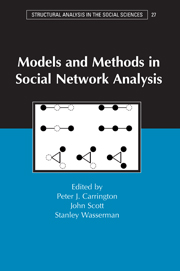Book contents
- Frontmatter
- Contents
- Acknowledgments
- Contributors
- 1 Introduction
- 2 Recent Developments in Network Measurement
- 3 Network Sampling and Model Fitting
- 4 Extending Centrality
- 5 Positional Analyses of Sociometric Data
- 6 Network Models and Methods for Studying the Diffusion of Innovations
- 7 Using Correspondence Analysis for Joint Displays of Affiliation Networks
- 8 An Introduction to Random Graphs, Dependence Graphs, and p*
- 9 Random Graph Models for Social Networks: Multiple Relations or Multiple Raters
- 10 Interdependencies and Social Processes: Dependence Graphs and Generalized Dependence Structures
- 11 Models for Longitudinal Network Data
- 12 Graphic Techniques for Exploring Social Network Data
- 13 Software for Social Network Analysis
- Index
- Structural Analysis in the Social Sciences
12 - Graphic Techniques for Exploring Social Network Data
Published online by Cambridge University Press: 05 June 2012
- Frontmatter
- Contents
- Acknowledgments
- Contributors
- 1 Introduction
- 2 Recent Developments in Network Measurement
- 3 Network Sampling and Model Fitting
- 4 Extending Centrality
- 5 Positional Analyses of Sociometric Data
- 6 Network Models and Methods for Studying the Diffusion of Innovations
- 7 Using Correspondence Analysis for Joint Displays of Affiliation Networks
- 8 An Introduction to Random Graphs, Dependence Graphs, and p*
- 9 Random Graph Models for Social Networks: Multiple Relations or Multiple Raters
- 10 Interdependencies and Social Processes: Dependence Graphs and Generalized Dependence Structures
- 11 Models for Longitudinal Network Data
- 12 Graphic Techniques for Exploring Social Network Data
- 13 Software for Social Network Analysis
- Index
- Structural Analysis in the Social Sciences
Summary
Social network analysts study the structural patterning of the ties that link social actors. For the most part, they seek to uncover two kinds of patterns: (1) those that reveal subsets of actors that are organized into cohesive social groups, and (2) those that reveal subsets of actors that occupy equivalent social positions, or roles.
To uncover patterns of those kinds, network analysts collect and examine data on actor-to-actor ties. Such data record who is connected to whom and/or how closely they are connected. Typically, the data are organized into square, N-dimensional, N by-N matrices, where the N rows and the N columns both refer to the social actors being studied. Cell entries in these matrices indicate either the presence/absence or the strength of some social relationship linking the row actor to the column actor. In this chapter, we deal only with symmetric relationships where, given a connection from actor i to actor j, actor j is also connected to i in the same way.
Network analysts sometimes use standard statistical procedures in examining their actor-by-actor matrices. Although there are several statistical modeling tools that have been developed specifically for network data (Holland and Leinhardt 1981; Wasserman and Pattison 1996), these tools were designed primarily for testing hypotheses. They do not provide a simple direct way to explore the patterning of network data – one that will permit an investigator to “see” groups and positions.
Information
- Type
- Chapter
- Information
- Models and Methods in Social Network Analysis , pp. 248 - 269Publisher: Cambridge University PressPrint publication year: 2005
Accessibility standard: Unknown
Why this information is here
This section outlines the accessibility features of this content - including support for screen readers, full keyboard navigation and high-contrast display options. This may not be relevant for you.Accessibility Information
- 51
- Cited by
